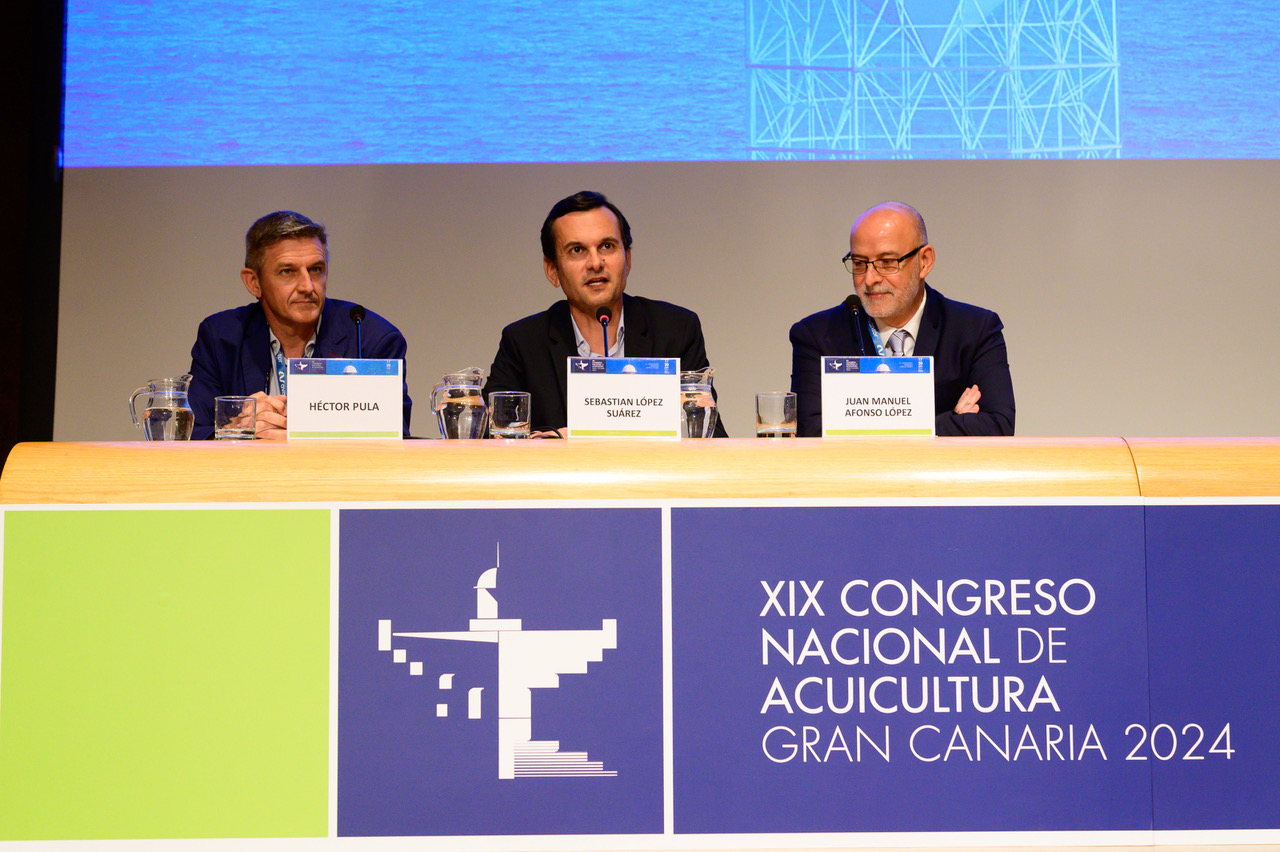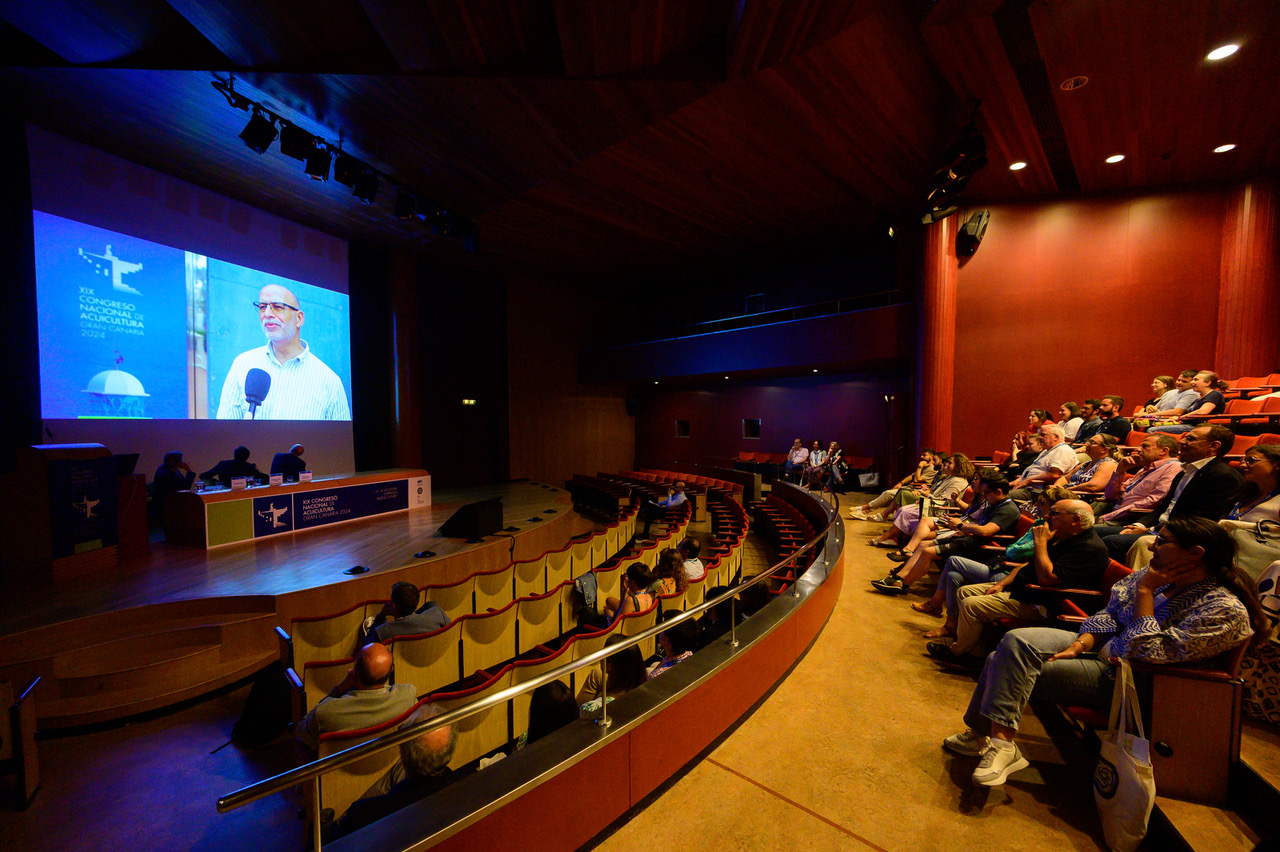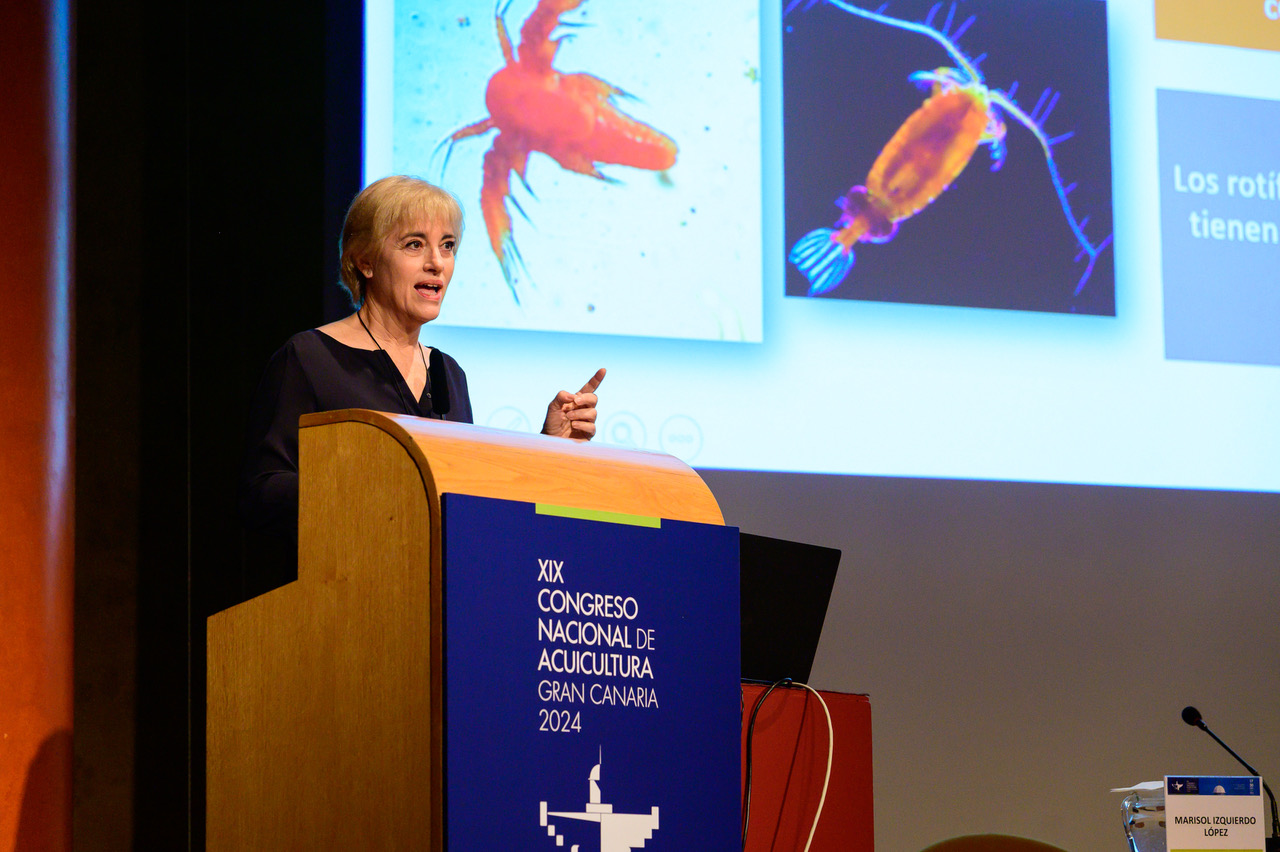The vice-rector of Research and Transfer of the ULPGC, Sebastián López, the president of the SEA, Héctor Pula, and the director of the GIA, Juan Manuel Afonso, close the congress with a master conference by the professor Marisol Izquierdo
The aquaculture expert, who affirmed that larval nutrition is ‘key’ to the proper fattening of the specimens, stressed that the survival rate obtained in semi-intensive hatcheries is ‘much higher’ than in commercial hatcheries, reaching up to 90%
The XIX National Aquaculture Congress (NAC), organised by the Spanish Aquaculture Society, in collaboration with the Aquaculture Research Group (GIA) of the ECOAQUA Institute of the University of Las Palmas de Gran Canaria (ULPGC), was closed yesterday afternoon, Wednesday 19th June, in the Chamber Hall of the Alfredo Kraus Auditorium in Las Palmas de Gran Canaria.
The event was attended by the vice-rector of Research and Transfer of the ULPGC, Sebastián López, the president of the Spanish Aquaculture Society, Héctor Pula, and the director of the GIA and president of the organising committee of the congress, Juan Manuel Afonso López.
 From left to right, at the presidential table, Héctor Pula, Sebastián López and Juan Manual Afonso.
From left to right, at the presidential table, Héctor Pula, Sebastián López and Juan Manual Afonso.
Vice- rector Sebastián López highlighted the fact that, for the first time in the history of Spanish aquaculture, the prestigious scientific journal 'Aquaculture' (Elsevier) is going to publish a special monographic volume to publish the best scientific papers of the 19th NAC ‘which have the highest quality standards and peer review’. He also pointed out that ‘Gran Canaria is the ideal place to hold this congress, not only because of our climate, this magnificent Auditorium and the care that the organisers have put into it, but also because aquaculture is the hallmark of our university, and if there is any scientific discipline in which we stand out, it is undoubtedly this one at world level’.
Pula, for his part, had words of thanks for the collaborating entities, as well as for the moderators and speakers who have participated in this event which, since last Monday, 17 June, has brought together more than 200 researchers and experts in the sector, and stressed that ‘at this congress the great diversity of species that are currently being studied has been visualised, which gives an image of the wealth of research being carried out in Spain, with great potential to be introduced into commercial exploitation’.
Larval nutrition, key
Before the closing ceremony, the ULPGC Professor of Aquaculture (Zoology), Marisol Izquierdo López, also a member of the GIA, gave the closing lecture of the XIX NAC under the title 'Larval nutrition: key element for optimal fattening'.
Izquierdo was introduced by the director of the GIA, Juan Manuel Afonso López, who stressed that the aquaculture developed at the ULPGC ‘we owe it’ to the work of this scientist who ‘came up with the idea in 1990 of structuring in a group all the activity of the people who did aquaculture in different areas at the ULPGC, around a single umbrella to have a greater potential’.

Afonso López highlighted the work of Izquierdo, who has produced "more than 200 papers and almost 100 competitive research projects", he said, not only for his role in scientific research, but also in scientific policy, obtaining funding and increasing the level of R&D at the ULPGC.
‘We wanted to close the congress by giving great importance to nutrition and its relevance in aquaculture, since more than 60% of the costs of maintaining the fattening of fish’ in the sector "are allocated’ to this area. ‘The other aspects are important, but nutrition is essential in the world of aquaculture’ , she stressed.
In this sense, Marisol Izquierdo stressed the importance of the nutrition of marine fish larvae not only for the production of fry in hatcheries, but also for their growth during the entire fattening process.
 Marisol Izquierdo during the closing speech.
Marisol Izquierdo during the closing speech.
‘As in humans, the nutritional history, i.e. the feeding pattern, during the early stages of development leaves a lasting impression on the fry and the adult fish. Even the feeding of the parents will be reflected in the growth and health of the offspring’, she said.
This phenomenon, known as nutritional programming, she explained, ‘is the effect that food and nutrients have at critical periods in life that can programme the body's development, metabolism and health for the future. In this way, the genes of the progeny will be affected epigenetically, modulating their expression in a programmed way’.
The professor pointed out that the survival obtained in semi-intensive hatcheries is much higher than in commercial hatcheries, reaching up to 90% more. ‘There is a study - she explained- recently published on the results of four commercial sea bream hatcheries in which it was found that the average survival of larvae at day 50 is approximately 26%’, a figure which, in her opinion, ‘is low’.
‘We often think that if 25% of the larvae survive, it means that the strongest, most robust and best quality 25% will survive. However, we know - Izquierdo said- that marine fish larvae have a much higher survival potential than they actually have in intensive hatcherie. In fact, she continued, ‘when we produce in semi-intensive or mesocosm-type systems, survival can increase, in the case of sea bream larvae, between 40% and even up to 90%’.
Izquierdo indicated that much progress has been made in the knowledge of larval nutrition, particularly in the last 10 years, in which the number of scientific publications on this subject has doubled. This information, on nutrients such as proteins, omega-3s and some vitamins and minerals, together with the development of new technologies in the production of microscopic diets, she said, ‘has favoured the appearance on the market of high-quality micro diets’.
‘However, there are still many challenges to be solved, such as the study of larval development in new species to aquaculture and the determination of their requirements. This information, in addition to allowing the expansion of these new species, can also be applied to other branches of science such as fisheries, and even in other vertebrate species, using larvae as a model to resolve issues including human health’, she concluded.


